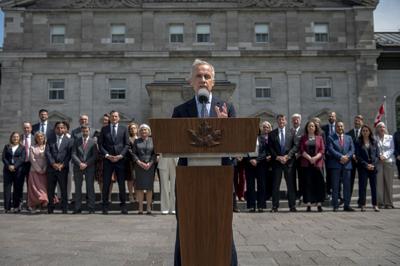The thing that has most characterized Mark Carneyās short career in politics is speed.
Itās easy to overlook the fact that he wonāt have completed four full months as an active politician until Friday of this week. It was, amazingly, only on Jan. 16 of this year that he went to a hockey rink in Edmonton and announced he was a candidate to lead the federal Liberal party.
Seventeen weeks later heās won that leadership, formed Cabinet No. 1, called and won an election campaignĢż²¹²Ō»å on Tuesday named Cabinet No. 2.
Another prime minister might be tempted to slow down for a moment and take a breath. Or at least to dial down expectations a touch. But Carney seems determined to keep up the frenetic pace.
He made a point of noting that his new cabinet was being sworn in faster following an election than any previous one. And that Parliament will resume quicker than itās ever done after a vote ā on May 26.
āWeāre starting as we aim to go on,ā he said, adding his government will act āwith urgency and determination.ā Cabinet No. 2, he said, is āsmaller and more focusedā than the previous one (i.e. Justin Trudeauās, not his own makeshift Cabinet No. 1).
Of course, thatās all relative. , including the PM himself, plus 10 junior secretaries of state, for a ministry of 39. It took just shy of two hours to have them all sworn in.
That may well be small-ish compared to recent bloated cabinets, but itās still a lot more than is actually needed to run the country. The United States, 10 times bigger, has a federal cabinet of 21. Germany has 17, plus the federal chancellor. The U.K. has 22, plus another five junior ministers. Australia has 23 and France just 17. There must be a comparable country with a national cabinet bigger than Canadaās, but it doesnāt spring readily to mind.
Of course, thatās because our federal cabinet isnāt only chosen to run the government. You could do that with maybe a dozen powerful ministers, but then you wouldnāt be able to accomplish all the other things the cabinet/ministry is expected to do in our system ā assure representation from every corner of the country; make sure various ethnic communities feel āheardā; find spots for Indigenous people (four in this ministry); get the language balance right; and of course these days make sure thereās gender balance or awfully close to it.
Carney also had another balancing act to do: finding the right tradeoff between experienced (i.e. Trudeau-era) ministers and newcomers, including those who ran for the first time under his banner. He split that right down the middle, with 14 holdovers and 14 new faces in the core cabinet.
Itās easy to second-guess some of those choices. But Carney avoided the obvious pitfalls. He kept Steven Guilbeault well away from any environmental/economic file and dumped Jonathan Wilkinson entirely, throwing a bone to Alberta and the West. Two new ministers ā and ā will now head the energy and environment departments. Carney kept Chrystia Freeland away from Canada-U.S. issues, given Donald Trumpās active hate on her. And he had MĆ©lanie Joly and Anita Anand swap jobs (Industry and Foreign Affairs), probably a win-win all round.
For the rest, it will all be in whether this group can rise to Carneyās promise ā and challenge to his ministers ā to act with āurgency and determination.ā The Trudeau government, especially as time wore on and became increasingly worn down, became notorious for āannouncement-itisā ā the tendency to confuse the announcement of a policy with the policy itself. Once the press release went out and the dollars were earmarked, they too often failed to follow up and make sure things got done.
Carney has promised quite different policies than Trudeauās. Heās stolen the Conservativesā clothes in many areas and pledges to deliver more āmanageableā immigration levels, faster homebuilding, a more energetic campaign against crime, a new relationship with the United States and nothing less than the ābiggest transformationā of the national economy since the Second World War.
Thatās a very tall order, but even more challenging is the new PMās pledge to deliver on all those promises and with all due speed. Thatās the bar heās set for his government and itās the measure by which he should be judged.





























To join the conversation set a first and last name in your user profile.
Sign in or register for free to join the Conversation